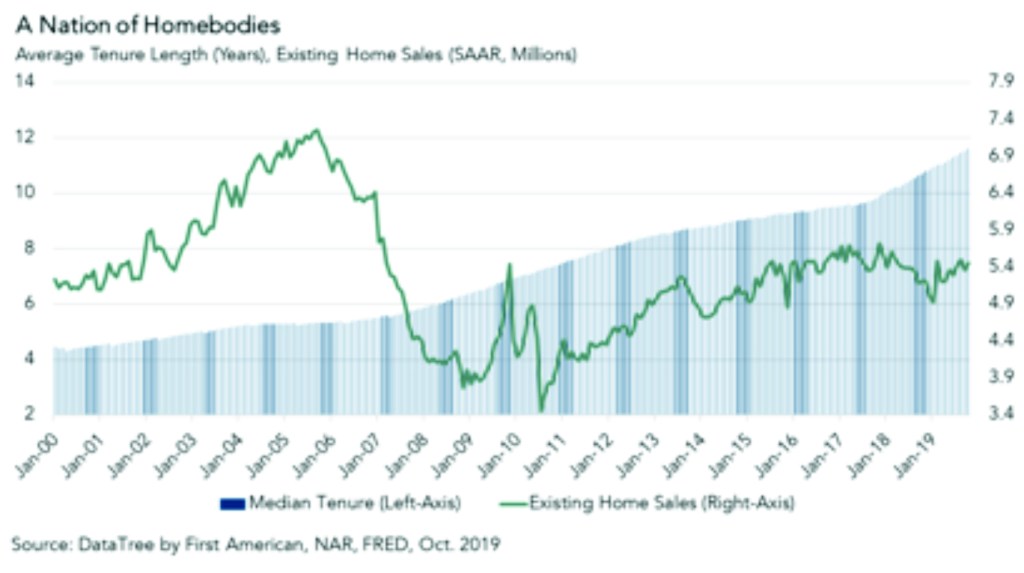
The housing market in 2019 surprised nearly everyone and was unexpectedly strong. The housing market benefitted from solid, Millennial-driven, first-time homebuyer demand, surprisingly another year of low mortgage rates and continued economic growth that pushed household income higher. Consequently, potential homebuyers saw their house-buying power surge in 2019. Their challenge? Finding something to buy and, in some markets, finding something affordable to buy.

Nationally, house-buying power-adjusted home prices remain well below the 2006 housing boom peak, but national averages mask the wide differences geographically. Affordability became a mounting concern in many expensive coastal markets, like San Francisco, Los Angeles, New York and Washington D.C. The missing piece to a balanced market puzzle? Supply.
Historically tight housing supply
Throughout the 1990s, housing inventory, the supply of homes for sale at any point in time measured as a percentage of the housing stock, has been between 2% and 2.5%. That may not seem like much, but given the number of occupied residential households in the U.S., that translates to between 2 and 3 million homes at any one point in time. The inventory was even higher in the housing boom of the early 2000s. The percentage of the housing stock for sale peaked at almost 4% at the end of 2006 at almost 4.5 million homes for sale. Of course, those homes weren’t staying on the market for very long! Fast forward to today and less than 2% of the housing stock is for sale.
Inventory levels are historically low compared with the last 30 years. But what’s different today? The trend in mortgage rates. Since the peak of the 30-year, fixed mortgage rate at almost 18% in 1982, the housing market has benefitted from consistently declining mortgage rates. Remember when mortgage rates were 10% in the late 1980s, 7% in the early 2000s and now less than 4%? Fear not the 5% mortgage in 2020, because the consensus among mortgage rate forecasters is that mortgage rates approaching 4% may be unlikely.
How trends in mortgage rates influence housing supply
The decades long decline in mortgage rates has fueled house-buying power growth, even if one’s household income did not change. This dynamic alone has helped inspire existing homeowners to sell and purchase a move-up home. Falling mortgage rates encourage selling, which means listing one’s home for sale and adding supply to the housing market.
Yet, the opposite is also true. Rising mortgage rates discourage selling, which means less inventory for the housing market. The 30-year fixed mortgage rate has remained below 5% since the end of the Great Recession. That was a decade ago, and the consensus among forecasters is that mortgage rates will remain below 4% for the next two years! While historically low rates increase buying power and make it more affordable for potential buyers to purchase a home, they also discourage many existing homeowners from selling because the only source of house-buying power growth is from rising household income.
Greater numbers of existing homeowners stay put and the inventory of homes for sale dwindles as fewer people sell their homes.

One way to see that existing homeowners are staying put is by measuring tenure length, or how long one stays in a home between moves. Prior to the recession, tenure length was less than six years on average. Now, it’s almost doubled to more than 11 years. This trend seems to be getting worse, as tenure length has increased more quickly in just the last 2.5 years.
Outlook for 2020
Based on the expectation that the decade-long era of historically low mortgage rates is now expected to continue through 2020 and even into 2021, it is reasonable to expect more existing homeowners to stay put and tenure length to continue to increase. That means that the lack of supply that the housing market experienced in 2019 is likely to persist in 2020. The missing piece of the housing market puzzle in 2020 will be supply.
Of course, it’s hard to buy what’s not for sale. Our analysis of the factors influencing the volume of existing-home sales indicates that rising tenure length is one of the biggest impediments to increased existing-home sales.
If supply is the missing puzzle piece in 2020, and we are reasonably certain that Millennial potential first-time homebuyer demand will continue to grow, then we can likely bank on one more trend in 2020 – faster house price appreciation. The actual year-over-year expectation for house price appreciation will depend heavily on your favorite house price index. There are many to choose from, and many of them began to accelerate in late 2019. Further acceleration of price appreciation is especially likely in the 2020 spring home-buying season.
In 2020, low mortgage rates and increased buying power will continue to boost demand, as will demographic tailwinds from Millennials aging into their prime home-buying years. Those same low rates will discourage many existing homeowners from selling, further restricting the primary source of supply to the housing market. The result of this supply and demand imbalance will be price appreciation. Yet, this doesn’t mean that the pace of existing-home sales will decline. Households don’t make the decision to sell based just on financial calculations. Jobs change and children are born – life circumstances alter one’s housing preferences.
While I expect staying put will be a more popular trend in 2020, making it hard to buy what’s not for sale, I also expect existing-home sales to remain about where they are today. Existing-home supply may be the missing puzzle piece in 2020, but the housing market has survived with a lack of supply for a few years already and the pace of new home construction has increased recently, doing its small part to alleviate some of that supply pressure. So, why not more of the same?





